云冈石窟
Yungang Grottoes - Yungang Caves - Yún gāng shíkū - Wuzhoushan Grottoes
Useful Information
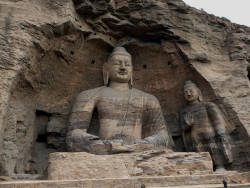
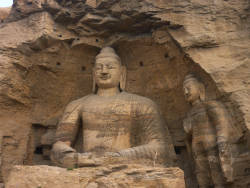
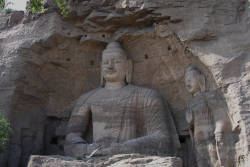
| Location: |
Near Datong City, Shaanxi Province.
(40.1105, 113.1259) |
| Open: |
APR to 15-OCT daily 8:30-17:30. 16-OCT to MAR daily 8:30-17. [2021] |
| Fee: |
APR to 15-OCT
Adults CNY 120, Children (6-18) CNY 60, Children (0-5) free, Student CNY 60, Seniors (60+) free, Disabled free, Chinese Military free. 16-OCT to MAR Adults CNY 80, Children (6-18) CNY 40, Children (0-5) free, Student CNY 40, Seniors (60+) free, Disabled free, Chinese Military free. Guide fee CNY 150, Chinese Audio Guide CNY 10, English Audioguide CNY 40. [2021] |
| Classification: |
 Cave Church,
Buddhist cave temples in sandstone Cave Church,
Buddhist cave temples in sandstone
|
| Light: | n/a |
| Dimension: | 252 caves and 51,000 statues |
| Guided tours: |
self guided, guides may be booked



|
| Photography: | partly allowed |
| Accessibility: | yes |
| Bibliography: |
James O. Caswell (1988):
Written and Unwritten: A New History of the Buddhist Caves at Yungang
Vancouver: University of British Columbia Press Vancouver: 225.
|
| Address: | Yungang Grottoes, Datong, Shanxi, 037007, Tel: +86-352-3029629, Tel: +86-352-3029632. |
| As far as we know this information was accurate when it was published (see years in brackets), but may have changed since then. Please check rates and details directly with the companies in question if you need more recent info. |
|
History
| 5th and 6th century | caves constructed. |
| 1952 | opened to the public. |
| 1961 | listed by the State Council among the first group of State Priority Protected Sites. |
| 2001 | inscribed on the UNESCO World Heritage List. |
| 2007 | first group of 5A level Chinese Tourist Areas. |
Description
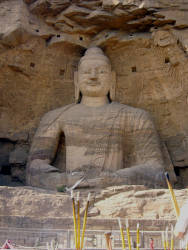
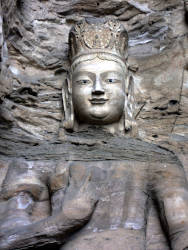
云冈石窟 (Yungang Grottoes, Cloud Ridge Caves) are Buddhist cave temples from the 5th and 6th centuries. They were formerly known as 武州山 or 武周山 (Wǔzhōushān, Mount Wuzhou), as they are located in the valley of the Shi Li river at the base of the Wuzhou Shan mountains. Most famous are the Five Caves created by Tan Yao, called a classical masterpiece of Chinese Buddhist art. All five caves have a strict unity of layout and design. They are known as caves No 16 through No 20.
The caves were excavated in the south face of a sandstone cliff which is 790 m long and between 9 m and 18 m high. In total there are 252 caves and niches and 51,000 statues within a carved area of 18,000 m². 53 caves are considered major caves, which means they have some size and a number of sculptures. Many caves are painted in different colours. There are no paintings, the sculptures are colorized.
The largest cave is No. 6, which is 20 m high, with a 15 m high pagoda-like column decorated with Buddha statues and designs. On the four sides of the column, and on the east, south and west walls of the cave, 33 embossed panels depict the story of Saykamuni.
There is a museum named The Yungang Exhibition Centre which gives a full introduction on how the Yungang Grottoes were created. The Yungang Culture and Art Performance Centre and Puppet Shadow House offer cultural programs. Especially on festivals like Yungang Culture and Art Festival, Culture Heritage Day, China Tourism Day, Mayday, the National Day and other lunar Chinese festivals.
- See also
 Subterranean World Heritage List
Subterranean World Heritage List Search DuckDuckGo for "Yungang Grottoes Shanxi"
Search DuckDuckGo for "Yungang Grottoes Shanxi" Google Earth Placemark
Google Earth Placemark Yungang Grottoes - Wikipedia (visited: 29-JAN-2021)
Yungang Grottoes - Wikipedia (visited: 29-JAN-2021) Yungang Grottoes, official website (visited: 29-JAN-2021)
Yungang Grottoes, official website (visited: 29-JAN-2021) Yungang Grottoes, The World Heritage List, UNESCO.
Yungang Grottoes, The World Heritage List, UNESCO. Yungang Grottoes - Masterpiece of Early Chinese Buddhist Cave Art (visited: 29-JAN-2021)
Yungang Grottoes - Masterpiece of Early Chinese Buddhist Cave Art (visited: 29-JAN-2021) Yungang Caves (visited: 29-JAN-2021)
Yungang Caves (visited: 29-JAN-2021) Yungang Grottoes - Atlas Obscura (visited: 09-NOV-2023)
Yungang Grottoes - Atlas Obscura (visited: 09-NOV-2023)
 Index
Index Topics
Topics Hierarchical
Hierarchical Countries
Countries Maps
Maps